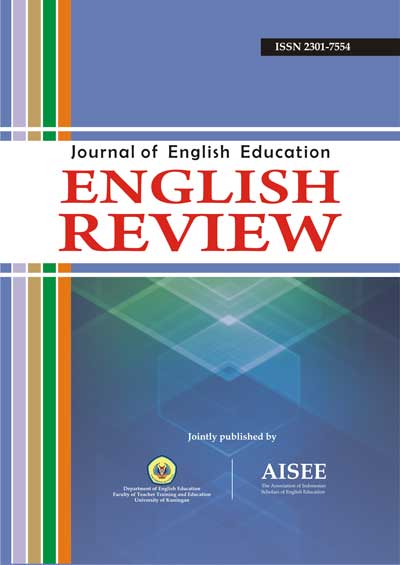AN ANALYSIS OF TEACHER AS MEDIATOR IN EFL CLASS
Abstract
Abstract: This paper concerned about how criteria of mediator applied in role of the teacher in EFL class and what the most dominant criteria of mediator done by the teacher in EFL class. It was limited to analyze the role of teacher as mediator based on Feuerstein’s Mediated Learning Experience criteria (1980) in Xiongyong et al., (2012). The method was qualitative research by using techniques structured observation and questionnaire that the process of teaching and learning was recorded by video then it was transcribed to identify the existence of criteria of mediator in the class. It also used observation worksheet to show the existence of criteria of mediator during three times observation. Based on the findings of the research, the teacher applied all criteria of mediator well which shared intention was the most dominant criteria that was done by the teacher in the class with percentage 87%. It means that the teacher made instructions clearly during the learning so that the students could understand about the lesson and present their tasks well.
Keywords: role of teacher, mediator, mediated learning experience, EFL class.
References
Aprijal, J. (2012). Teaching narrative text using grammar-translation method to improve writing ability at the tenth grade students of SMK Al-fathonah Cilaku-Cianjur. Retrieved on March 25, 2014, from http://publikasi.stkipsiliwangi.ac.id/files/2012/09/09220498-julius-a.pdf
Brown, H. D. (2000). Teaching by principles: An interactive approach to language pedagogy (2nd ed.). California: Longman.
Creswell, J. W. (2009). Research design (3rd ed.). California: Sage Publications Inc.
Fraenkell, J R., & Wallen, E N. (2009). How to design and evaluate research and education (7th ed.). New York: McGraw-Hill Higher Education.
Lauder, A. (2008). The status and function of English in Indonesia: A review of key factors. Makara, Sosial Humaniora, 12 (1), 9-20. Retrieved on September 10, 2014, from http://journal.ui.ac.id/index.php/humanities/article/viewFile/128/124
Seng, S. (1997). Using mediated learning experience to enhance children’s thinking. 1-11. Retrieved on August on 30, 2014, from http://files.eric.ed.gov/fulltext/ED406052.pdf
Sugiyono. (2012). Metode penelitian pendidikan. Bandung: Alfabeta.
Xiongyong, C. (2011). Performance of mediation and situational constraints of China’s secondary school EFL teachers. International Journal of English Linguistics, 12 (1), 230-240. Retrieved on August 30, 2014, from doi:10.5539/ijel.v1n2p230
Xiongyong, C., Samuel, M., & Hua, C. (2012). Evaluation on EFL teacher roles from the perspective of mediation: Case studies of China’s secondary school classroom practices. International Review of Social Sciences and Humanities, 3 (1), 117-134. Retrieved on August 26, 2014, from http://irssh.com/yahoo_site_admin/assets/docs/13_IRSSH-239-V3N1.131230957.pdf
Xiongyong, C. (2012). Cognition of mediation among secondary school EFL teachers in China. International Journal of Business and Social Science, 3 (14), 223-244. Retrieved on August 30, 2014, from http://ijbssnet.com/journals/Vol_3_No_14_Special_Issue_July_2012/25.pdf
All articles published in English Review: Journal of English Education (ERJEE) are licensed under the Creative Commons Attribution 4.0 International License (CC BY 4.0).
Copyright Ownership
Authors retain the copyright of their articles and grant ERJEE the right of first publication. The journal is granted a non-exclusive license to publish, reproduce, and distribute the article in any format, medium, or platform, provided that proper credit is given to the original authors.
License Terms – CC BY 4.0
Under the Creative Commons Attribution 4.0 International License, others are free to:
- Share — copy and redistribute the material in any medium or format
- Adapt — remix, transform, and build upon the material for any purpose, even commercially
As long as they:
- Provide appropriate credit to the original author(s) and source
- Provide a link to the license (https://creativecommons.org/licenses/by/4.0/)
- Indicate if any changes were made
There are no restrictions on the reuse, reproduction, or adaptation of published articles as long as attribution is properly given.
Author Warranties
By submitting a manuscript to ERJEE, authors confirm that:
- The work is original and does not infringe any existing copyright.
- The manuscript has not been previously published and is not under consideration elsewhere.
- All sources and references are appropriately acknowledged.
- Necessary permissions have been obtained for any copyrighted materials used.










